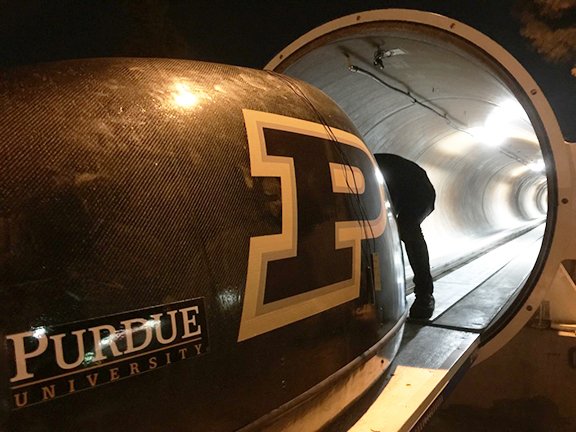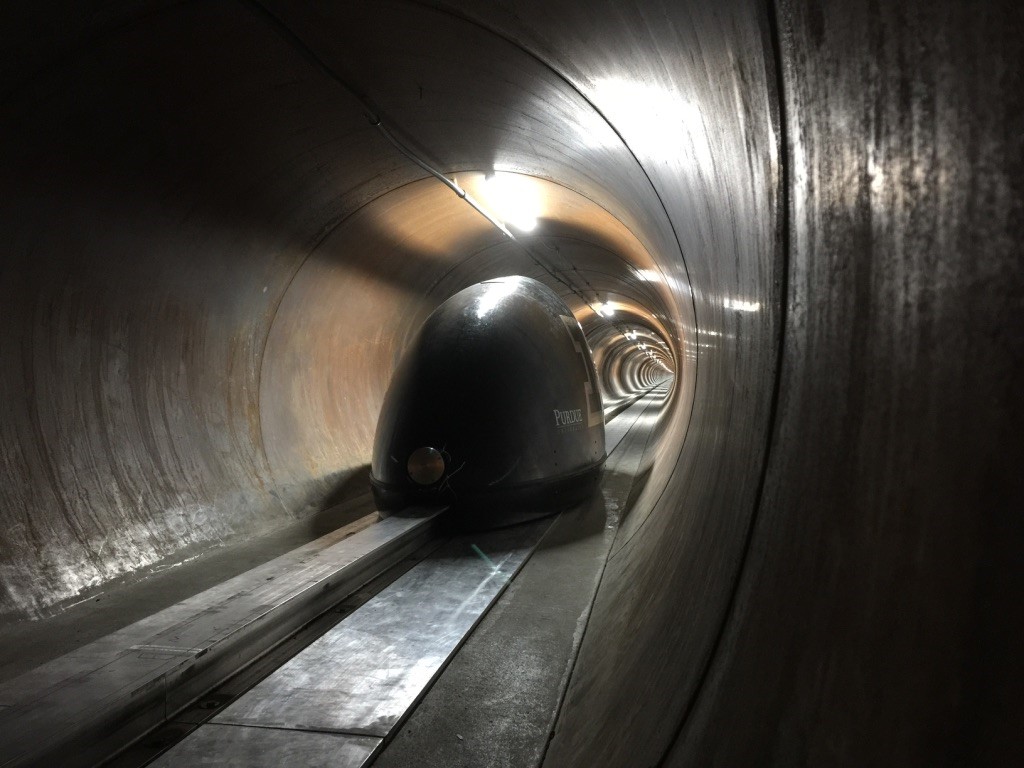Purdue Hyperloop on track for summer competition
 Purdue Hyperloop will spend the Spring semester refining its pod, in preparation for a second competition this summer. The team made a solid showing at the first Hyperloop competition hosted by SpaceX at its headquarters in Hawthorne, CA. Hyperloop is a proposed mode of high-speed transportation that would propel passengers and/or cargo in a pod-like vehicle through a near-vacuum tube.
Purdue Hyperloop will spend the Spring semester refining its pod, in preparation for a second competition this summer. The team made a solid showing at the first Hyperloop competition hosted by SpaceX at its headquarters in Hawthorne, CA. Hyperloop is a proposed mode of high-speed transportation that would propel passengers and/or cargo in a pod-like vehicle through a near-vacuum tube.
Purdue Hyperloop began as a design class in Fall 2015, with AAE Prof. Alina Alexeenko teaching the class and advising the team. AAE Prof. John Sullivan also helped advise the team in the design process. For the 2016-2017 academic year, Mechanical Engineering Professsor Purdue Hyperloop Guillermo Paniagua is serving as team advisor.
 The Purdue team was one of 27 teams that traveled to California to test their pods last month — but was one of only seven teams whose pods met the stringent requirements to be tested on the three-quarter mile track SpaceX built for the competition. Purdue Hyperloop Project Manager and AAE student Richard Brookes says in order to be cleared for a run on the test track, teams had to prove their pods could fit in the tube and that their braking systems worked.
The Purdue team was one of 27 teams that traveled to California to test their pods last month — but was one of only seven teams whose pods met the stringent requirements to be tested on the three-quarter mile track SpaceX built for the competition. Purdue Hyperloop Project Manager and AAE student Richard Brookes says in order to be cleared for a run on the test track, teams had to prove their pods could fit in the tube and that their braking systems worked.
Brookes says even though there wasn’t enough time during the competition weekend for Purdue to test its pod under full race conditions, he is happy with the team’s performance overall.
 “As with any big project, you’re rushing to get a few things done,” says Brookes. “We were right down to the wire trying to get everything to work. Then right around the start of the competition, everything just came together really nicely. Everything on the pod was functioning just as we wanted it to.”
“As with any big project, you’re rushing to get a few things done,” says Brookes. “We were right down to the wire trying to get everything to work. Then right around the start of the competition, everything just came together really nicely. Everything on the pod was functioning just as we wanted it to.”
In addition to seeing their pod work, Brookes says one of the best parts of the weekend was interacting with Elon Musk.
“He came over and looked at our pod and complimented the sleek design,” says Brookes. “We got compliments from (Musk) and a lot of SpaceX people about the quality of our composites work. Purdue does excellent composites work, and we were the only fully composites pod in the competition.”
Brookes says the team will analyze the data gathered from the pod’s run on the test track and use it to make improvements for the summer competition, once again hosted by SpaceX. The winners of Hyperloop Competition II will be determined based on a single criterion: maximum speed.
The award-winners from the Hyperloop I competition were as follows:
- Fastest team: WARR Hyperloop.
- Highest overall score: Delft Hyperloop.
- Safety and reliability award: MIT Hyperloop.
- Performance and operations: University of Maryland. Honorable mention: Virginia Tech, Purdue, Hyperlift (St. John’s High School, Texas).
- Performance in flight: WARR Hyperloop.
- Innovation: Badgerloop (University of Wisconsin at Madison) and Team rLoop (the contest’s only non-student team, organized through Reddit). Honorable mention: VicHyper (Royal Melbourne Institute of Technology, Australia).
- Design and construction: The top 10, from 1 to 10, are Delft, WARR, MIT, Virginia Tech, University of Maryland, University of Washington, Purdue, Carnegie Mellon University, Hyperlift, Keio Alpha.
top photo: Purdue Hyperloop poses with its pod in the atrium of the Neil Armstrong Hall of Engineering
middle photo: Purdue Hyperloop pod entering the test track at the Hyperloop competition hosted by SpaceX at its headquarters in Hawthorne, CA
bottom photo: Purdue Hyperloop pod inside the test track at the Hyperloop competition hosted by SpaceX at its headquarters in Hawthorne, CA
